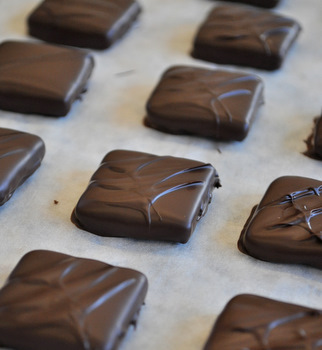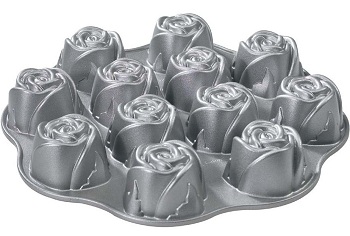
Tempering is a word that means improving the consistency, durability or hardness of a substance by heating and cooling it. Many substances, including metals, are tempered but the most important one might be chocolate. Tempered chocolate is very glossy, has a firm finish and melts smoothly at around body temperature. It is chocolate at its very best, and tempered chocolate is what most good quality chocolate candies, candy bars and bon bons are made out of.
Tempering is done by melting solid chocolate to a temperature high enough that the crystals in the cocoa butter (yes, there are tiny crystals in your chocolate) break down. This temperature is between 110-120F. Once the chocolate is fully melted, it must be cooled to about 82F, a temperature at which crystals will start to form again so that the chocolate can eventually re-solidify. The chocolate’s temperature is then raised back to about 90F, where it is very fluid and can be poured into chocolate molds and used for other applications. All chocolate – white, milk and dark - can be tempered.
The crystals that start to form when the chocolate is cool (Beta 5 crystals, if you want to get specific) are stable crystals contained in the cocoa butter of chocolate. They provide the necessary structure for the chocolate to become shiny, smooth and have a good “snap” when it is set. Chocolate that has not been tempered or that has been improperly tempered will look flat or discolored. It will lack the sharp “snap” of tempered chocolate and will typically not be as smooth as it melts.

Tempering can be done in several ways (tutorial coming soon) by hand, and there are also machines available that can temper chocolate for you. If tempering by hand, it is very helpful to have a good digital thermometer handy to get the temperatures correct. Experienced chocolate makers can often do this by feel alone, but a thermometer will help keep you on the right track as you work with your chocolate. Tempering by hand can be done by tabliering (pictured above), where melted chocolate is poured onto a cool marble surface and worked with spatulas until it has cooled down sufficiently. More melted chocolate is added back and incorporated in to the tabliered chocolate to bring it back to the finial working temperature. Another process is called seeding. For this process, chocolate is melted and a small amount (about 25%) of finely chopped solid chocolate is added into the melted chocolate and stirred in. Adding solid chocolate lowers the temperature of the melted chocolate and starts to temper the melted chocolate.
When it comes to baking, chocolate does not need to be tempered because it is being incorporated into another form. You could use tempered chocolate in your brownie recipe, for instance, but it would not improve the taste or texture of your brownies from plain melted chocolate because it is mixed with sugar, butter, flour and other ingredients, then baked. Similarly, chocolate does not need to be tempered to make chocolate ganache or chocolate frosting, as there are other ingredients added to the chocolate in generous quantities relative to the amount of chocolate.
If you are going to dip strawberries, marshmallows or homemade thin mints in chocolate, you may want to use tempered chocolate for a shinier finish. Don’t worry if tempering chocolate sounds intimidating, however, because if you dip those berries into regular melted chocolate and store them in the refrigerator, they’ll keep their nice glossy finish even though the chocolate hasn’t been tempered.
Update: This tutorial should help you easily temper chocolate at home using a method called “seeding.”






Elle @ Chellbellz
January 26, 2012I have to come back and look at all this…I’m starving so much and trying to stay away from the chocolate!
Maureen
January 27, 2012what a great post. I love playing with chocolate (as my husband calls it) and every time I do, I get better at it. I’ll re-read your instructions before I try again, thanks!
Cindy
January 27, 2012Thanks for the article. I was wondering how to temper chocolate by hand at home. I can’t wait for the tutorial.
Sheelagh@anirishvillagepantry
January 29, 2012Really looking forward to the tutorial, trying home-made chocolates for my market stall is the next goal. Thanks!
Rosa Lym
November 27, 2013Having setup a recent store for baking enthusiasts I have newcomers to the art enquiring about any and everything to do with it. This article has proven your willingness to spread the facts. Thanks very much for your information.
Any like enquiries will be passed on to you for your enlightenment. Thanks for your support.